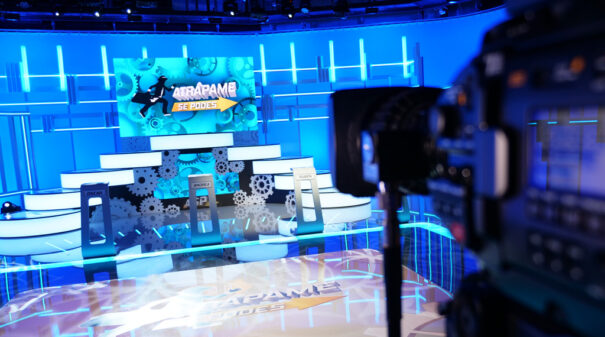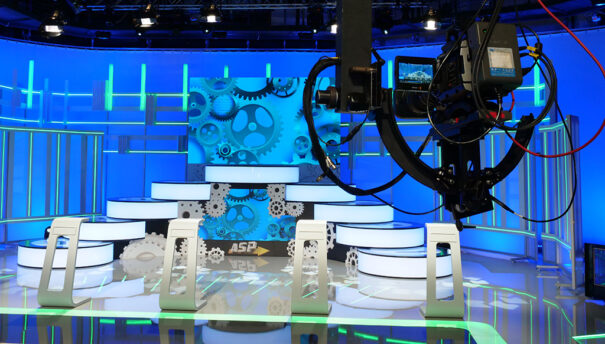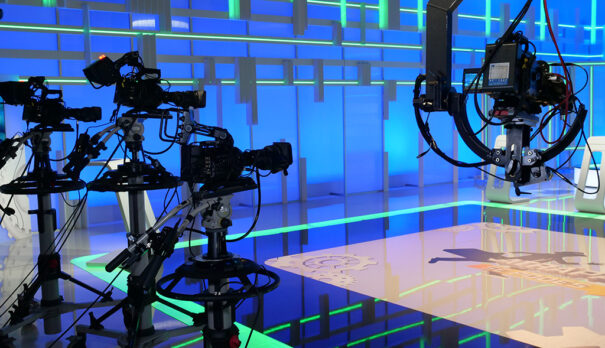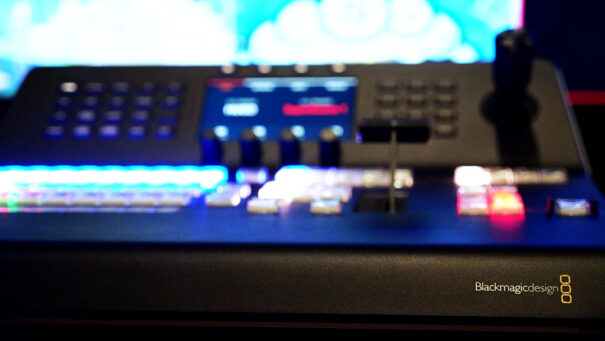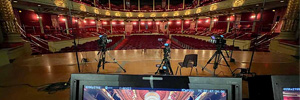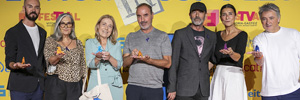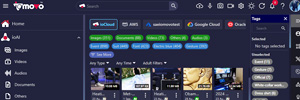'Atrápame se podes': technology at the service of versatility in the TVG contest
Anxo Noya Castro, director técnico de Audiovisual Voice, detalla el flujo de trabajo que da vida a ‘Atrápame se podes’, adaptación del mítico concurso autonómico para tvg que cobra vida apoyado en una amplia selección de equipos Blackmagic.
Atrápame se podes, adaptación para la televisión gallega de Atrápame si puedes, sempiterno concurso con una larga trayectoria en numerosas televisiones autonómicas españolas, no es otro de los concursos televisivos que estamos acostumbrados a ver en los últimos tiempos.
El formato original de Hostoil continúa la tradición de aquellos formatos en los que el dinamismo y el conocimiento ocupan un papel predominante. Los candidatos tendrán que medir su sabiduría con el objetivo de pasar de fases hasta llegar a un último desafío en la que podrán optar al preciado bote. Con más o menos fases o duración dependiendo de la identidad del concurso en cada región en España, la adaptabilidad del formato y su engagement con la audiencia le ha permitido mantenerse en antena durante varios años.
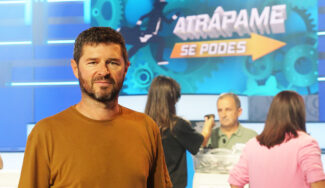 La versión gallega de este formato, Atrápame se podes, es una coproducción entre Mediapro y Audiovisual Voice, veterana productora con 38 años de trayectoria que asume toda la labor de producción y postproducción del formato. Lejos de los platós espectaculares, grandes recursos tecnológicos o sets que albergan a decenas de concursantes, el programa encuentra su máximo desafío en la optimización de recursos para poder abordar un ritmo de grabación muy veloz and one fase de postproducción en la que se minimizan al máximo las transcodificaciones y renders para entregar másteres a TVG en tiempo récord.
La versión gallega de este formato, Atrápame se podes, es una coproducción entre Mediapro y Audiovisual Voice, veterana productora con 38 años de trayectoria que asume toda la labor de producción y postproducción del formato. Lejos de los platós espectaculares, grandes recursos tecnológicos o sets que albergan a decenas de concursantes, el programa encuentra su máximo desafío en la optimización de recursos para poder abordar un ritmo de grabación muy veloz and one fase de postproducción en la que se minimizan al máximo las transcodificaciones y renders para entregar másteres a TVG en tiempo récord.
Anxo Noya Castro abre la puerta de la vertiente más tecnológica del concurso para dar a conocer un flujo de trabajo materializado en más de 750 episodios en apenas tres años.
Agilidad: el máximo requisito de Atrápame se podes
Para remarcar el alto ritmo de producción de Atrápame se podes, Noya subraya que el equipo de más 50 personas de Voz Audiovisual que da forma al formato graba cinco programas al día. tvg apostó por realizar una adaptación del formato diaria, de modo que cada semana se emiten cinco episodios de este concurso; episodios estándar que, en fechas señaladas como navidades, adquieren una nueva dimensión con distintos especiales.
“Al final, lo que buscamos son valores de producción que nos permitan hacer un mayor aprovechamiento de los recursos”
Para poder cumplir este ritmo de trabajo, la productora gallega apuesta por tener un flujo de trabajo “claro, mecanizado y muy ágil”, de modo que todos los presentes en el plató tengan claras sus funciones: “Los cámaras se saben sus planos, el realizador actúa de forma mecánica, el sistema de grafismo se añade en set…”. Como reconoce Noya, hay muy poco para la improvisación y la EDL final será muy similar en cada uno de los episodios. No debe ser visto como algo negativo, sino la culminación de un proceso de exploración para poder optimizar los recursos de cara a un concurso que tiene entre sus bondades la consistencia y solidez. El espectador sabe lo que se va a encontrar, y su apoyo a esta propuesta queda denotada en su audiencia del 13,3%, dos puntos por encima de la media de la cadena. “La estructura del programa ni se ha modificado ni se ha variado su duración. Nos funciona muy bien y tenemos una audiencia muy estable”, cuenta Noya.
Algunas de las adaptaciones de catch me if you can para otras autonómicas de España se graban desde un mismo plató, que se modifica ligeramente o se personaliza a través del grafismo para aportar ese extra de identidad. El caso de Atrápame se podes es diferente: Voz Audiovisual rueda el formato desde uno de sus cuatro estudios, donde los recursos escénicos están instalados permanentemente. Esta decisión, más allá de aportar un extra de comodidad al talento implicado en la producción y al equipo de Voz Audiovisual, ha permitido a la productora optimizar sus soluciones tecnológicas hasta perfeccionar una fórmula a día de hoy consolidada.
Captación en HD con la adaptabilidad por bandera
La transición del SD al HD, como para otras productoras, supuso un antes y un después en Voz Audiovisual. La compañía gallega transformó toda su infraestructura tecnológica de sus dos estudios de realización, así como realizó una importante inversión en soluciones de captación 4K con la que dio forma a series como Néboa, siguiendo así una larga trayectoria en la ficción iniciada con películas como La lengua de las mariposas (1999) u otros formatos televisivos como Mareas vivas.
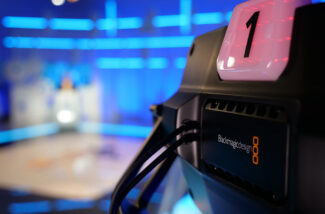 En paralelo, Noya y su equipo identificó en el mercado la oportunidad de completar su equipamiento para formatos de televisión más tradicionales con las cámaras URSA Broadcast G2 de Blackmagic. Voz Audiovisual se decantó por estas soluciones de captación tanto por su bajo coste como por su adaptabilidad a muchos de los requisitos que pudieran tener en el día a día de la productora: “Nos decantamos por esta cámara porque nos permite grabar este tipo de programas en configuración de estudio, y también nos da la posibilidad de usarla de modo autónomo en otro tipo de formatos como documentales, publicidad o series. Al final, lo que buscamos son valores de producción que nos permitan hacer un mayor aprovechamiento de los recursos”.
En paralelo, Noya y su equipo identificó en el mercado la oportunidad de completar su equipamiento para formatos de televisión más tradicionales con las cámaras URSA Broadcast G2 de Blackmagic. Voz Audiovisual se decantó por estas soluciones de captación tanto por su bajo coste como por su adaptabilidad a muchos de los requisitos que pudieran tener en el día a día de la productora: “Nos decantamos por esta cámara porque nos permite grabar este tipo de programas en configuración de estudio, y también nos da la posibilidad de usarla de modo autónomo en otro tipo de formatos como documentales, publicidad o series. Al final, lo que buscamos son valores de producción que nos permitan hacer un mayor aprovechamiento de los recursos”.
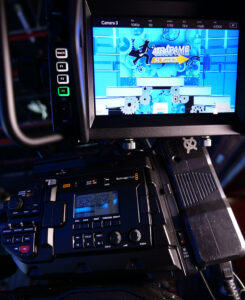 URSA Broadcast G2 en Atrápame se podes
URSA Broadcast G2 en Atrápame se podes
Las URSA Broadcast G2 también se adaptan a la perfección a las necesidades de Atrápame se podes, puesto que las características del programa hacen que con una inversión baja se pueda obtener el “máximo rendimiento” al aprovechar equipamiento que Voz Audiovisual ya poseía como ópticas, trípodes o cableados: “Como hablamos de un formato muy definido y mecánico, las necesidades también están muy delimitadas”.
Al margen de cuestiones de automatización y sincronización, que todavía se encuentran en fase de pruebas y podrá ayudar a Voz Audiovisual a mejorar la puesta en escena de Atrápame se podes en el futuro cercano, Noya destaca como bondades de las cinco cámaras que componen la producción su acabado visual (contrastado pero apto para el formato que preparan), así como la capacidad de grabar contenido directamente a 1080 50p, lo que agiliza en gran medida la fase de postproducción.
Un programa, un día: la ágil postproducción de Atrápame se podes
Voz Audiovisual graba cada capítulo de Atrápame se podes con cinco URSA Broadcast G2 de Blackmagic conectadas a través de una matriz VideoHub 40×40 a un mezclador Atem Constellation 4K, controladas por un Atem Camera Control Panel y capturado con cuatro grabadores Hyperdeck Studio HD Pro. El realizador produce en tiempo real el formato, introduciendo gráficos y haciendo una premezcla cuyas fuentes son ingestadas en un NAS conectado mediante una red de 10 GB a los puestos de postproducción.
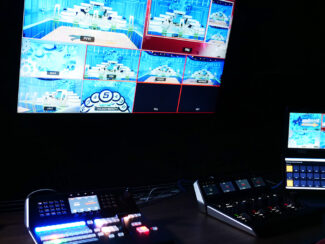 Una vez que un auxiliar de montaje se encarga de la sincronización de las fuentes de las cámaras y del programa realizado, los montadores ocuparán una jornada en realizar el montaje final de cada uno de los episodios en estaciones MAC con Avid Media Composer. La EDL final, que principalmente se basa en la reducción de los 50 minutos brutos del rodaje a unos 35 minutos, será enviada a un terminal adicional que se encarga de la exportación del programa realizado. Finalmente, la masterización a los requisitos de emisión de TVG se llevará a cabo con DaVinci Resolve o Adobe Media Encoder.
Una vez que un auxiliar de montaje se encarga de la sincronización de las fuentes de las cámaras y del programa realizado, los montadores ocuparán una jornada en realizar el montaje final de cada uno de los episodios en estaciones MAC con Avid Media Composer. La EDL final, que principalmente se basa en la reducción de los 50 minutos brutos del rodaje a unos 35 minutos, será enviada a un terminal adicional que se encarga de la exportación del programa realizado. Finalmente, la masterización a los requisitos de emisión de TVG se llevará a cabo con DaVinci Resolve o Adobe Media Encoder.
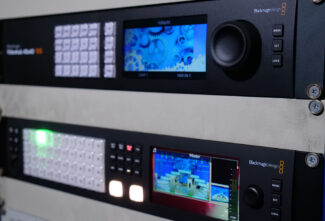 El flujo de trabajo podría parecer convencional de no ser por la ausencia de proxys en el proceso. La decisión, hecha posible gracias a contar una red de amplia capacidad y a los formatos exportables a través del ecosistema de Blackmagic, tiene como contras el importante tamaño de los archivos, que suman 2 TB por jornada. Los beneficios, como cuenta Noya, son superiores: “Como la postproducción es tan inmediata, decidimos editar de forma nativa sobre los brutos. Es un ahorro importante de tiempo, pues no tenemos que realizar ningún tipo de transcodificación”.
El flujo de trabajo podría parecer convencional de no ser por la ausencia de proxys en el proceso. La decisión, hecha posible gracias a contar una red de amplia capacidad y a los formatos exportables a través del ecosistema de Blackmagic, tiene como contras el importante tamaño de los archivos, que suman 2 TB por jornada. Los beneficios, como cuenta Noya, son superiores: “Como la postproducción es tan inmediata, decidimos editar de forma nativa sobre los brutos. Es un ahorro importante de tiempo, pues no tenemos que realizar ningún tipo de transcodificación”.
“Como la post-production es tan inmediata, decidimos editar de forma nativa sobre los brutos. Es un ahorro importante de tiempo, pues no tenemos que realizar ningún tipo de transcodificación”.
Optimización de recursos, agilidad y adaptabilidad vertebran cada una de las decisiones de Audiovisual Voice to Atrápame se podes, un camino que Noya y su equipo seguirán explorando semana a semana para seguir llevando al siguiente nivel su trabajo. A veces, la creatividad de las producciones no debe residir tanto en el formato, sino en las decisiones que lleven a la mejor gestión posible de los recursos.
A report by Sergio Julián Gómez
Did you like this article?
Subscribe to our NEWSLETTER and you won't miss anything.



